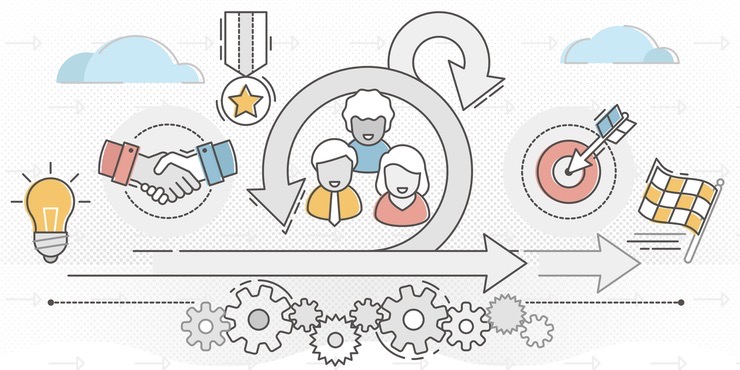In my previous article, we explored the transformative concept of Agile HR, a practice that marries Agile methodology with a human-centric approach to modernize workforce management. As discussed, Agile HR is all about flexibility, collaboration, and iterative progress, redefining HR practices and reshaping the candidate, client and employee experience. In this article, let’s take a look at real-world use cases that showcase how organizations are effectively implementing Agile HR to meet the dynamic demands of their workforce.
1. Agile HR in Talent Acquisition and Onboarding
- Sprint-Based Recruitment: Agile HR breaks down the recruitment process into sprints, typically lasting 1-2 weeks, allowing HR teams to focus on specific tasks, such as sourcing, screening, and interviewing candidates.
- Real-time Adjustments: Continuous feedback loops involve hiring managers and candidates, enabling quick adjustments in response to changing job requirements or emerging priorities.
- Swift Decisions: It empowers organizations to make prompt decisions, even mid-sprint, when a candidate with unique skills becomes available.
- Candidate-Centric Approach: It prioritizes creating a positive candidate experience, ensuring transparent and timely communication throughout the hiring process.
According to Gartner, organizations using Agile HR practices report a remarkable 21% reduction in time-to-fill job positions compared to traditional HR methods. Read this article to learn more about Agile Recruitment.
2. Agile HR in Performance Management
- Frequent Check-Ins: It encourages managers and employees to engage in frequent check-ins, replacing the traditional annual performance review.
- Continuous Feedback: Employees receive timely feedback on their performance, allowing for real-time adjustments.
- Adaptive Goals: Goals are set and adjusted regularly, aligning with changing business priorities.
- Employee Development: Agile HR focuses on individual development plans, enabling employees to acquire new skills and competencies as needed.
This approach allows for efficient progress tracking and provides timely feedback and recognition to employees. As a result, Agile performance management focuses on both employee development and organization growth.
3. Agile HR in Employee Engagement and Feedback
- Frequent Pulse Surveys: It uses pulse surveys or feedback mechanisms to collect employee opinions on an ongoing basis.
- Rapid Issue Resolution: Concerns or issues are addressed promptly, preventing escalation.
- Iterative Improvement: Employee feedback is leveraged to refine HR processes, policies, and initiatives, fostering continuous improvement.
- Employee Empowerment: Employees actively shape workplace policies, initiatives, and cultural changes.
According to McKinsey & Company, organizations using Agile HR in their performance management practices experience an impressive 20% boost in employee engagement scores. In a well-managed Agile transformation, results trigger employee engagement across the organization and a faster response to priorities. It also enables the allocation of resources to top business needs.
4. Agile HR in Global Workforce Management
- Localized Adaptations: It acknowledges regional differences, tailoring HR practices to meet local regulations, cultural expectations, and workforce needs.
- Centralized Core: While encouraging local adaptations, there’s often a centralized core of HR practices and policies maintaining consistency and alignment with global organizational goals.
- Cross-Border Collaboration: Agile HR promotes collaboration among HR teams in different regions, enabling the sharing of best practices and insights.
- Global Talent Mobility: It supports global talent mobility, facilitating the transfer of employees across borders and ensuring they have the necessary support and resources.
Agile global workforce management maximizes flexibility while optimizing resource costs. Additionally, it enables HR leaders to productively use resources, minimize project risk, and emphasize remote collaboration and communication.
5. Agile HR in Diversity and Inclusion Initiatives
- Inclusive Hiring Practices: It incorporates diversity and inclusion into every stage of the hiring process, from job postings to candidate evaluations.
- Regular Diversity Metrics Tracking: It uses metrics to track diversity progress, making adjustments when goals are not met.
- Employee Resource Groups: It encourages the formation of employee resource groups (ERGs) and provides them with resources to drive diversity and inclusion initiatives.
- Inclusive Training: Training programs are adapted to foster inclusivity and cultural competence among employees.
Agile and data go hand in hand. DEI data builds the foundation of an effective DEI strategy. Company leaders and lawyers may worry that collecting diversity data may produce evidence of discrimination that could lead to lawsuits. However, Harvard Business Review points out ways to minimize the legal threats while embracing the use of metrics. DEI data reflect how well the initiatives are working and provide reference points for reaching DEI goals. This keeps leaders accountable and on track for success.
These real-world use cases demonstrate how Agile HR principles are being effectively implemented to enhance HR practices, improve employee experiences, and drive organizational success. As HR professionals, who may be new to the concept, are starting to embrace Agile practices to adapt the ever-evolving workforce and organizational needs, we anticipate an increase in potential failure. But here’s the good news: this indicates that processes are being deployed faster, and solutions to problems can be developed much more effectively.





